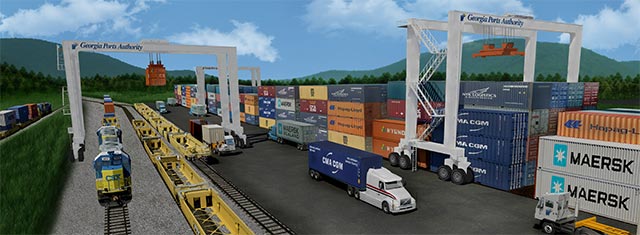Georgia Residents Hire Attorney, Form Nonprofit to Fight Proposed Inland Port

 A Georgia Ports Authority rendering of the proposed inland port.
A Georgia Ports Authority rendering of the proposed inland port.A group of Murray County, Georgia, residents don't want to see a bucolic 42-acre pasture on U.S. Highway 411 just north of the unincorporated community of Crandall turned into an "inland port" where shipping containers would be transferred from semi-trucks to railcars.
So they've formed a nonprofit group, hired an attorney and will hold a public meeting a week from today to prepare for battle.
And it's shaping up as a David versus Goliath meeting since the proposed Appalachian Regional Port has powerful backers, including Georgia Gov. Nathan Deal, the Georgia Ports Authority, Murray County Sole Commissioner Brittany Pittman and CSX Transportation, the largest railroad east of the Mississippi.
The port's supporters say it would make Georgia's carpet, flooring, auto and tire industries more competitive on the global market. And the facility would take shipping containers off semi-trucks for the 388-mile trip by rail to the Georgia Port Authority's Garden City Terminal just northwest of Savannah— removing 35,000 to 50,000 semi-trucks annually from Atlanta-area highways.
That might be good for Atlanta — but it makes no sense for Murray County, said Michael Jones, president of the Murray County nonprofit group that opposes the inland port, the Northern Georgia Citizens to Preserve the Environment.
"I don't know why we need 50,000 trucks in a sleepy county, in rural Murray County," said Jones, who added that his group has about 250 supporters. "I don't see why you need to put this in the middle of a hay field, close to the Cohutta Wilderness on a scenic byway 22 miles from the nearest interstate. It is just not logical."
Along with increased traffic, the group's concerns include decreased property values, noise and light pollution, and the shipment of potentially hazardous materials.
So the citizens' group has retained attorney James David "J.D." Rogers from the Atlanta law firm DeLong, Caldwell, Bridgers and Fitzpatrick.
"He came recommended through a friend of ours," Jones said.
Rogers, a graduate of The Citadel and a retired U.S. Marine Corps colonel, specializes in eminent domain. Jones thinks that is likely to be an issue.
"Forty-two acres might be enough to get this started," Jones said. "But it's not going to be enough to go anywhere or expand. So they're going to have to condemn land and take it. I can almost guarantee that's where it's headed."
Forty-two acres will be enough, and the Georgia Ports Authority won't use eminent domain, said John Trent, the authority's senior director of strategic operations and safety.
"We're only using 26 or 27 acres of the 42-acre site," Trent said. "The long-range planning that we have that goes out 15 to 20 years, we won't ever need to go outside that [42 acres]."
Trent said he spoke about a month ago with Rogers, who was a class ahead of Trent at The Citadel, which they both attended as undergraduates. Trent said he provided documents that Rogers sought through an open records request.
"He advised me at that point that there was no pending litigation, that he was doing fact-finding," Trent said.
'We want to be good neighbors'
Trent said truck traffic from the inland port, at its peak, won't be worse than traffic was in Murray County before the economic slowdown of 2008 shuttered industry there.
And Trent said the port authority will take steps to soften the impact of the inland port. Mitigations would include building an 8-foot-high berm topped by an 8-foot-high wooden fence between the proposed rail yard and the nearby Fairy Valley Baptist Church.
"I will tell you that we are committed to being good neighbors," Trent said. "We are committed to doing all the right things to make sure we mitigate as much of their concerns as we can."
The citizens group plans to raise objections when the U.S. Army Corps of Engineers looks at the proposed inland port's environmental impact.
"We hope to be able to do that, yes," Jones said. "But we plan to have an environmental study done on our own."
Jones thinks a better location for the proposed inland port would be in Dalton, Georgia, near the South Dalton Bypass alongside Interstate 75.
That would be "cost-prohibitive," Trent said.
"At the South Dalton Bypass, there was only one location where we had the opportunity to eventually build an inland port," he said. "The problem that we ran into is it became fairly cost-prohibitive to build."
Putting the inland port there would have cost an extra $25 million to $30 million, he said, because it would have required demolishing and then rebuilding a bridge on the South Dalton bypass that has railroad tracks underneath it.
But, according to Jones' calculations, Dalton would be a cheaper site.
"To take a two-lane rural road, and make it a four-lane rural road — which is what they'll have to do if this thing goes anywhere — will cost about $86 million," Jones said.
The Appalachian Regional Port is estimated to cost about $24 million. The state will pay $10 million, the Georgia Port Authority $7.4 million, CSX $5.5 million and Murray County $700,000, Trent said.

